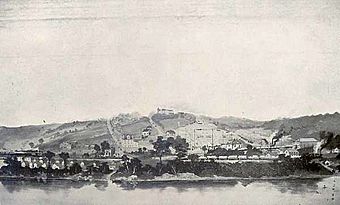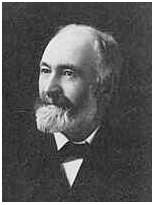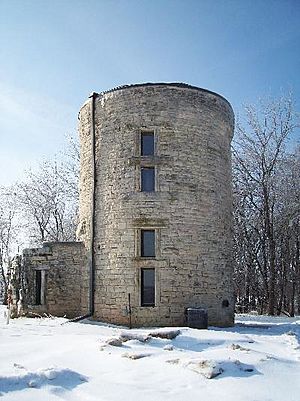John A. Green Estate facts for kids
Quick facts for kids |
|
|
John A. Green Estate
|
|

John A. Green Estate late 1800s
|
|
| Location | Off U.S. Route 151, Stone City, Iowa |
|---|---|
| Area | 200 acres (0.81 km2) |
| Built | 1882 - 1889 |
| Architect | Green, John A. |
| Architectural style | Late Victorian |
| NRHP reference No. | 78001232 |
| Added to NRHP | August 31, 1978 |
The John A. Green Estate (also called the Green-Nissen Estate) is a special historical place in Stone City, Iowa. This large property covers about 200 acres (0.81 km²). The buildings on the estate were made from Anamosa Limestone. This stone came from quarries owned by John Green himself.
The estate was added to the U.S. National Register of Historic Places in 1978. This means it is an important place in American history. Later, in 2008, it also became part of the larger Stone City Historic District.
The Story of the Green Estate
John A. Green started his Champion quarries on March 17, 1868. At that time, the area was mostly wilderness. For almost 50 years, these quarries were very busy. They sold over 4.5 billion dollars worth of stone.
By 1896, about 1,000 people worked in the quarries. They carved out 160,000 loads of stone in just one year. This stone was worth about 3.75 million dollars. John Green was most productive between 1869 and the 1890s. During this time, he ran three quarries. These were called "Champion 1," "Champion 2," and "John Allen." He even used workers from the nearby Anamosa State Penitentiary.
In 1883, John Green built a large building called Columbia Hall. It was a three-story hotel and opera house. This building was made from 500,000 tons of stone. Famous performers of the time came to entertain people there. In the 1930s, Columbia Hall was bought and then torn down in 1938. Its stone was reused for other projects.
The Stone City Art Colony
In 1920, Frank Nissen bought 200 acres (0.81 km²) of the Green Estate. In the summers of 1932 and 1933, the estate became home to the Stone City Art Colony. Famous artist Grant Wood, along with Edward Rowan and Adrian Dornbush, started the Colony in 1932.
They had very little money, just over $100. They also made promises to pay later based on the Colony's success. They rented 10 acres (40,000 m²) of land on the estate. This land included the Green Mansion, the Ice House, and the Water Tower. The top floor of the mansion became a place for students to sleep. The rest of the house had offices, a kitchen, a sculpture studio, and showers.
The basement of the ice house was turned into a bar. It was called The Sickle and Sheaf. An instructor and student named Dennis Burlingame worked there. The top part of the water tower became an apartment for Adrian Dornbush. Students called it Adrian's Tomb.
Important Buildings and Structures
- The Green Mansion: This large house was built in 1882. It sat on a hill with a view of the city. The mansion had 20 rooms and seven fireplaces made of Italian marble. It also had hand-painted pictures on the walls and two bathrooms. In the early 1930s, the Green family sold the estate to Frank Nissen. The mansion later became the summer home of poet Paul Engle. In 1963, a fire damaged the Green Mansion. It was torn down in the 1990s. Only its foundation remains today.
- The Stone Barn: John A. Green built this barn in 1889. It is very big, about 12,000 square feet (1,100 m²), and stands 30 feet (9.1 m) tall. It has six strong supports called buttresses along its side. Each buttress is 3 feet (0.91 m) wide at the bottom. The barn was first used to keep draft horses for John Green's quarry business. It could hold up to 100 horses. The barn also had a blacksmith shop, a three-story storage area, and rooms for the stable workers. People in Stone City say it took 80 men 80 days to build this huge stone barn. Today, the barn is a private home.
- The Water Tower: This tower was built on a high spot of the Green Estate. It provided water for the whole estate, including John Green's limestone quarry. In the summer of 1932, during the Stone City Art Colony, the water tower was used as an apartment. Art instructor Adrian Dornbush lived there. Students at the Colony called it Adrian's Tomb. In 2008, the water tower was bought and fixed up. It is now a gift shop.
Images for kids








